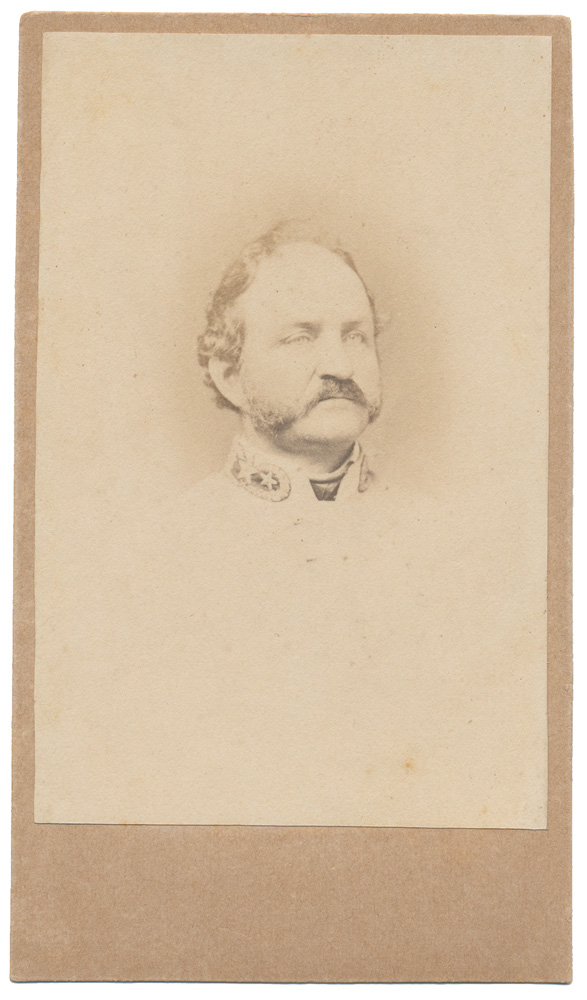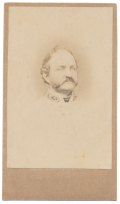site search
online catalog
CDV OF C.S. GENERAL JOHN S. WILLIAMS

$300.00 SOLD
Quantity Available: None
Item Code: 1138-559
Bust view carte de viste of Williams in Confederate uniform with only his collar visible. His general’s collar insignia is clearly visible. Image is clear but slightly light. No photographer’s backmark.
John Stuart Williams (July 10, 1818 – July 17, 1898) was a general in the Confederate States Army during the American Civil War and a postbellum Democratic U.S. Senator from Kentucky.
Williams went to Prestonburg in early 1861 and was commissioned colonel of the 5th Kentucky Infantry. He served initially in the Eastern Theater, under Humphrey Marshall in southwestern Virginia. He participated in Marshall's ill-fated invasion of eastern Kentucky in 1862; and fought for Marshall at the victory at the Battle of Princeton Court House. Marshall resigned soon thereafter and was sent to eastern Tennessee. The brigade then spent a short period of time fighting for Loring, skirmishing at Fayetteville and reaching Charleston. Loring was then transferred to the Mississippi, replaced by John Echols. Williams was promoted to brigadier general in late 1862 and assigned temporary command of the Department of Southwestern Virginia, replacing Echols. He was replaced by General Samuel Jones.
He organized a brigade of cavalry and helped resist Ambrose Burnside's invasion of eastern Tennessee in 1863. He transferred to Georgia, assuming command of the Kentucky regiments in Wheeler’s cavalry. He received a formal resolution of thanks from the Second Confederate Congress in the fall of 1864 for his actions at the Battle of Saltville.
Williams returned home following the war and went on to engage in agricultural pursuits, with his residence in Winchester, Kentucky. He again became a member of the State House in 1873 and 1875. He was elected to the United States Senate in 1879 and served from March 4, 1879 to March 3, 1885. Williams became involved in land development in Florida in the late 1880s. He died in Mount Sterling in 1898 and was interred in Winchester Cemetery in Winchester. [jet] [ph:L]
~~~~~~~~~~~~~~~~~~~~~~~~~~~~~~~~~~~
THIS ITEM, AS WITH ALL OTHER ITEMS AVAILABLE ON OUR WEB SITE,
MAY BE PURCHASED THROUGH OUR LAYAWAY PROGRAM.
CLICK HERE FOR OUR POLICIES AND TERMS.
THANK YOU!
Inquire About CDV OF C.S. GENERAL JOHN S. WILLIAMS
For inquiries, please email us at [email protected]
Most Popular
Historical Firearms Stolen From The National Civil War Museum In Harrisburg, Pa »
Theft From Gravesite Of Gen. John Reynolds »
Selection Of Unframed Prints By Don Troiani »
Fine Condition Brass Infantry Bugle Insignia »
British Imported, Confederate Used Bayonet »
Scarce New Model 1865 Sharps Still In Percussion Near Factory New »
featured item
RARE USN GOSPORT NAVY YARD PRIMING FLASK
Gosport Shipyard was the original name of the facility in Portsmouth, Virginia, that was founded in 1767, passed into the hands of Virginia in the Revolution, was leased from that state by the U.S. government in 1794, purchased by them in 1801 and… (490-6824). Learn More »
site search
Upcoming Events
May 16 - 18: N-SSA Spring Nationals, Fort Shenandoah, Winchester, VA Learn More »



